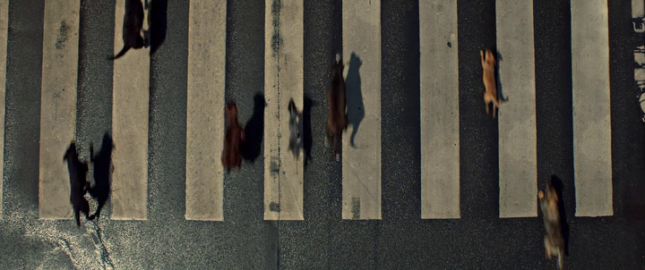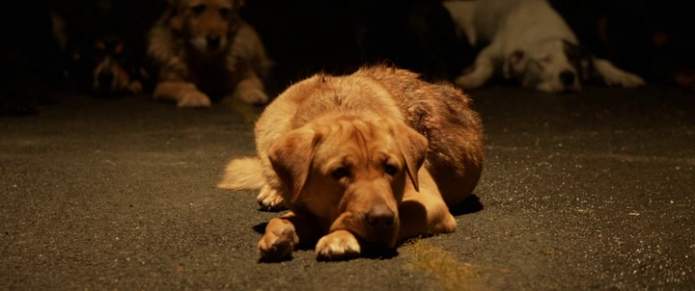It is interesting how the English language approximates these two particular words, “God” and “Dog”. Actually, “approximate” might not be the ideal term, as one word effectively mirrors the other, but the matter of fact is that I keep referring to Kornél Mundruczó’s movie as “White Dog”. I can either believe that I am inherently dyslexic, or that, in this particular case, this is no coincidence. After seeing this brilliant movie, I am more inclined to believe in the latter.

It is easier to describe the story rather then the style of the movie, so I’ll start with the former. Lili (Zsófia Psotta) is left with her father (Sándor Zsótér) while her mother and step-father go away for a conference (which in this world apparently lasts for 3 months). She has a dog, a “mutt”, Hagen, which the father is not very keen on keeping around. In fact, the whole society does not look kindly into these types of mixed-breeds. From the upstairs neighbour to the city and government officials, there is a general despise and overall rejection of these animals which are considered “unfit” to exist their society. There is a very strong socio-political allegory underlying this tale, but as pulsating as this feels throughout the movie, the story is never reduced to that single aspect.

It doesn’t take long until Hagen is on the streets by itself. At this point in the movie, we follow the two “mutts” (Hagen and Lili) in parallel, as both are kind of lost in the world. Lili, heartbroken for being separated with the only other being that accepted and valued her properly, deals with a father with whom she cannot communicate and with colleagues from the musical conservatory that look at her as the weird kid. She feels abandoned and an outcast, and tries to sneak into parties with older kids, ending up getting very bored and numb with alcohol. Hagen, on the other hand, learns about the abuses of the world, and from the humans that he once trusted. Hungry and scared, he finds the company (and competition) of other stray dogs, who are chased incessantly by the city health officials. Up until this point, we might consider this as a more adult “Beethoven”, with the dogs becoming best buddies and helping each other out escaping their chasers. But the story gets really dark, really fast. Hagen is captured by a homeless man and eventually sold to someone who trains dogs for fighting. He is beaten, starved, provoked and transformed into a vicious fighting animal. This is not an easy movie to watch and one hopes, more than ever, that the “no animals were harmed” statement is true. Eventually, Hagen is taken into a shelter where he literally snaps and becomes the leader a violent dog uprising against humans. And revenge is all that exists in his mind.

One of the most amazing characteristics of the movie is the absence of generated graphics for the scenes. Every dog in the movie (and there are a lot of them) is real and they are (or were*), indeed, abandoned dogs. One has to assume that a lot of patience was needed to train these dogs to become proper actors (seriously, some scenes with all these dogs are uncanny). That, and a brilliant cinematography, which confers a wider depth to the behaviour of the animals. It is remarkable the way that framing is used here to confer purpose and meaning to the actions of the dogs. And yet, it all feels so natural. There is a delicious scene in the very beginning, right after Hagel is left abandoned, where we accompany his exploratory stroll over a bridge by the Danube. Suddenly, a boat honks its horn and he is puzzled in that particular way of curious dogs, with their spiked ears and rigid posture. This back and forth between the natural behaviour of dogs and their human-like representation (the look in Hagen’s eyes where he realizes he killed another dog is haunting) is brilliantly maneuvered.

The movie exists in a sort of surrealist universe and wanders around different styles, jumping from a type of coming-of-age story, into an apocalyptic setup, back into family drama, and then a very gory slasher monster movie. It is a unique mixture, but one that works very well with the socio-political dark fairy tale underneath. It is both very violent and very sweet, but it never feels heavy handed or forced. Almost everyone that had and loved a dog knows that the connection that is formed is very special. There is a sort of canine adoration of their humans who, in turn, rely on their faithful companions to be there, unconditionally, to cheer them up and to love them. It is one of those kinds of connections that easily surpasses the “utility” factor and taps into the kinds of forces that connect us, emotionally, to other beings. And this connection with dogs is unlike any other.

Here, I come back to the title. The “White God” is a subversion of what we know and see in the movie. First, the animals are everything but “white” in the sense of “clean”: as beautiful as the scenes are, the dogs are gritty, dirty and messy. Then, the expectation that we, the humans, are dogs’ gods (and which is true at the beginning) is completely reversed, with a tentative epitome of this occurring in the very last scene, which mimics the famous image of the prostrated Pope in front of the altar. But don’t be fooled: God is neither in one or the other, neither in the fearing subjects or in the powerful almighty entities. They are all prostrated, but they are not looking down into the ground. Instead they look into each others’ eyes. God, or this “White God”, this powerful, naturally pure entity, exists in-between them. It exists in acceptance, in tolerance, in trust, in the ability to overcome injustice and prejudice, and in the ability to forgive. And it exists in the almighty love that emanates from the ties that unite a girl and her dog.

*Apparently, all the stray animals that were used in the movie were not only very well treated, but at the end of filming were put into homes.
